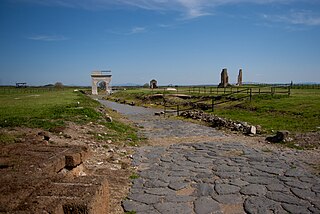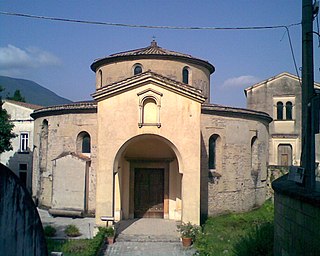
Empúries was an ancient city on the Mediterranean coast of Catalonia, Spain. Empúries is also known by its Spanish name, Ampurias. The city Ἐμπόριον was founded in 575 BC by Greek colonists from Phocaea. After the invasion of Gaul from Iberia by Hannibal the Carthaginian general in 218 BC, the city was occupied by the Romans. In the Early Middle Ages, the city's exposed coastal position left it open to marauders and it was abandoned.

Orvieto is a city and comune in the Province of Terni, southwestern Umbria, Italy situated on the flat summit of a large butte of volcanic tuff. The city rises dramatically above the almost-vertical faces of tuff cliffs that are completed by defensive walls built of the same stone, called tufa.

Civita di Bagnoregio is a town in the Province of Viterbo in central Italy, a suburb of the comune of Bagnoregio, 1 kilometre (0.6 mi) east from it. It is about 120 kilometres (75 mi) north of Rome. The only access is a footbridge from the nearby town, with a toll introduced in 2013. Due to the toll, communal taxes were abolished in Civita and nearby Bagnoregio. Due to its unstable foundation that often erodes, Civita is famously known as ‘the dying city’.

Singidunum was an ancient city which later evolved into modern Belgrade, the capital of Serbia. The name is of Celtic origin, going back to the time when Celtic tribe Scordisci settled the area in the 3rd century BC, following the Gallic invasion of the Balkans. Later on, the Roman Republic conquered the area in 75 BC and incorporated it into the province of Moesia. It was an important fort of the Danubian Limes and Roman Legio IV Flavia Felix was garrisoned there since 86 AD. Singidunum was the birthplace to the Roman Emperor Jovian. It was sacked by Huns in 441, and by Avars and Slavs in 584. At the beginning of the 7th century, the Singidunum fort was finally destroyed.

Tarquinia, formerly Corneto, is an old city in the province of Viterbo, Lazio, Italy known chiefly for its ancient Etruscan tombs in the widespread necropoleis or cemeteries which it overlies, for which it was awarded UNESCO World Heritage status.

Cerveteri is a town and comune of northern Lazio in the region of the Metropolitan City of Rome. Known by the ancient Romans as Caere, and previously by the Etruscans as Caisra or Cisra, and as Agylla by the Greeks, its modern name derives from Caere Vetus used in the 13th century to distinguish it from Caere Novum.

Tuscania is a town and comune in the province of Viterbo, Lazio Region, Italy. Until the late 19th century the town was known as Toscanella.

Caere is the Latin name given by the Romans to one of the larger cities of southern Etruria, the modern Cerveteri, approximately 50-60 kilometres north-northwest of Rome. To the Etruscans it was known as Cisra, to the Greeks as Agylla and to the Phoenicians as Kyšryʼ.

Centuripe is a town and comune in the province of Enna. The city is 61 kilometres (38 mi) from Enna in the hill country between the Rivers Dittaìno and Salso.

Asciano is a comune and hill town in the province of Siena in the Italian region Tuscany. It is located at the centre of the Crete senesi between the river Ombrone and the torrent Copra, some 30 kilometres (19 mi) southeast of the town of Siena by rail.

Vulci or Volci was a rich and important Etruscan city.

Vetulonia, formerly called Vetulonium, was an ancient town of Etruria, Italy, the site of which is probably occupied by the modern village of Vetulonia, which up to 1887 bore the name of Colonnata and Colonna di Buriano: the site is currently a frazione of the comune of Castiglione della Pescaia, with some 400 inhabitants.

Aléria is a commune in the Haute-Corse department of France on the island of Corsica, former bishopric and present Latin Catholic titular see. It includes the easternmost point in Metropolitan France.

Nocera Superiore is a town and comune in the province of Salerno in the Campania region of south-western Italy.

Capranica is a comune (municipality) in the Province of Viterbo in the Italian region Lazio, located about 55 kilometres (34 mi) northwest of GRA, 66 kilometres (41 mi) from Rome’s centre, and 24.5 kilometres (15.2 mi) southeast of Viterbo.
The Fanum Voltumnae was the chief sanctuary of the Etruscans; fanum means a sacred place, a much broader notion than a single temple. Numerous sources refer to a league of the "Twelve Peoples" (lucumonies) of Etruria, formed for religious purposes but evidently having some political functions. The Etruscan league of twelve city-states met annually at the Fanum, located in a place chosen as omphalos, the geographical and spiritual centre of the whole Etruscan nation. Each spring political and religious leaders from the cities would meet to discuss military campaigns and civic affairs and pray to their common gods. Chief amongst these was Voltumna, possibly state god of the Etruria.

A necropolis is a large, designed cemetery with elaborate tomb monuments. The name stems from the Ancient Greek νεκρόπολις nekropolis, literally meaning "city of the dead".

Cadyanda or Kadyanda was a town of ancient Lycia. The site was discovered by Charles Fellows. The decree of Pixodarus now in the British Museum shows that the Lycian name of the town was Xadawãti.

The Monterozzi necropolis is an Etruscan necropolis on a hill east of Tarquinia in Lazio, Italy. The necropolis has about 6,000 graves, the oldest of which dates to the 7th century BC. About 200 of the tomb chambers are decorated with frescos.

Etruscan architecture was created between about 900 BC and 27 BC, when the expanding civilization of ancient Rome finally absorbed Etruscan civilization. The Etruscans were considerable builders in stone, wood and other materials of temples, houses, tombs and city walls, as well as bridges and roads. The only structures remaining in quantity in anything like their original condition are tombs and walls, but through archaeology and other sources we have a good deal of information on what once existed.
























